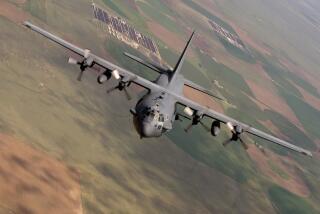Instruments Identify MIGs : F-14 Cockpit a Crucible for Lightning Decisions
- Share via
WASHINGTON — In labeling as hostile the two Libyan aircraft shot down over the Mediterranean on Wednesday, the pilot of the lead U.S. F-14 fighter took into account many of the same factors that led the skipper of the U.S. cruiser Vincennes to mistakenly declare an approaching Iranian airliner unfriendly last July.
Both officers considered the approaching aircraft’s point of origin, altitude and airspeed. Both listened for the distinctive sound of their radar and identification systems.
The Vincennes, based on that information, fired a single Standard missile. Its target turned out to be a civilian Airbus, and all 290 aboard were killed.
Under equally crushing time pressure, the two F-14s in Wednesday’s episode fired a total of four Sidewinder and Sparrow missiles, probably even before they could see the approaching aircraft. Their targets proved to be MIG-23 military jets.
Unlike the Vincennes, however, the U.S. F-14s, flying 50 miles south of their mother ship, received signals that indicated the enemy’s radar had been turned on, though whether the radar was targeting them or was being used for navigation or weather information remained unclear from Defense Department accounts.
Also, unlike the cruiser’s sailors, the pilots benefited from the eyes and ears provided by the carrier John F. Kennedy, its escort ships and the E-2C Hawkeye, a sophisticated airborne radar-warning plane that circled high over the Mediterranean.
Even so, they had to act at breathtaking speed. The F-14 Tomcat is capable of flying at more than 1,500 m.p.h., and its missiles travel at upward of 2,000 m.p.h. The MIG-23 has a top speed of nearly 1,400 m.p.h. and carries weapons that, like the F-14, can engage targets beyond its pilot’s eyesight.
Navy officials said that such speeds give pilots little time to make critical determinations on the identity and intent of rapidly approaching aircraft. For an aviator who could be as young as 26 years old, the responsibility--and the consequences--can be awesome.
Defense Secretary Frank C. Carlucci, who stressed that his own information was preliminary, said there is little doubt that the Libyans were flying in a threatening manner. But to aviators on routine patrols within range of hostile bases, that information, and the decisions that proceed from them, come step by well-rehearsed step.
The lumbering Hawkeye aircraft, crowned with a rotating radar dish and operating off the Kennedy’s decks, spotted the Libyan MIGs shortly after they lifted off from the air base at the Libyan port of Al Bumbah, U.S. officials said.
Under routine procedures, naval officers said, that information would be passed to several of the fighter planes from the Kennedy then flying “CAP,” or carrier air patrol, in a wide ring around the carrier.
On the Hawkeye’s sweeping radar screens, the Libyan planes would appear only as tiny blips. Their departure point, Al Bumbah, where several of Libya’s 260 fighter aircraft are based, gave one vital clue to their identity.
Almost immediately, the Hawkeye’s sensitive electronic eavesdropping equipment would tune in to listen for the MIGs’ distinctive “squawk,” or electronic identification signals. At the same time, it would pick up the planes’ weather and search radars, which would help confirm that the aircraft were military.
Defense officials said that the Hawkeye gleaned another crucial piece of information--the sound of Libyan military ground controllers directing the MIG pilots. The exchanges confirmed that the Libyan pilots were not renegades but were carrying out orders.
Pilots Alerted
When the Libyan warplanes entered the cone-shaped swath of airspace for which the pair of F-14s was responsible, radar operators aboard the Hawkeye warned the pilots of the sleek U.S. fighters, then flying at 15,000 feet.
Inside the cockpit of the two F-14s, said former naval aviators, all attention would be drawn to the radar screen. In each, the pilot and his back-seat radar-weapons officer would begin the process of pinpointing the approaching threat and checking its available weapons.
With a distinctive growl, the heat-seeking Sidewinder missiles strapped under the F-14s indicated to the crew that they had located the warm exhaust of the closing MIGs and were ready to go. The pilots knew their radar-guided Sparrow missiles, designed to reach more distant targets, would easily find their way to the jets, still well outside of view.
As the Libyan planes narrowed the gap between themselves and the F-14s from 70 to 14 miles, the U.S. jets began a series of evasive actions, designed in part to test the intentions of the potential adversary.
Carlucci said that when the F-14s dropped to 4,000 feet and “jinked” up and down and back and forth in a series of high-speed maneuvers, the Libyan planes followed suit in a potentially deadly game of follow the leader.
“They took some five different evasive actions, and each time, the Libyan aircraft sought to put their nose on our aircraft,” said Carlucci. “They also accelerated.”
As the five-minute drama reached its height, defense officials said, instruments on the F-14s emitted the dreaded but unmistakable sound that signified that the Libyan planes had turned on their radars.
The high-pitched warbling might have signified that the Libyans had turned their targeting radars on the F-14s. Or it might have merely reflected the use of navigation or weather radar. Carlucci declined to elaborate.
When the MIGs had closed to 14 miles, the lead U.S. pilot decided “he could wait no longer,” Carlucci said.
Operating under peacetime rules of engagement, which allowed them to fire their weapons to protect themselves from planes and ships displaying hostile intent, the two F-14s fired three Sparrows and one Sidewinder.
Then the F-14 crews turned back toward the aircraft carrier Kennedy, spotting a pair of parachutes as they floated toward the sea.
More to Read
Sign up for Essential California
The most important California stories and recommendations in your inbox every morning.
You may occasionally receive promotional content from the Los Angeles Times.














